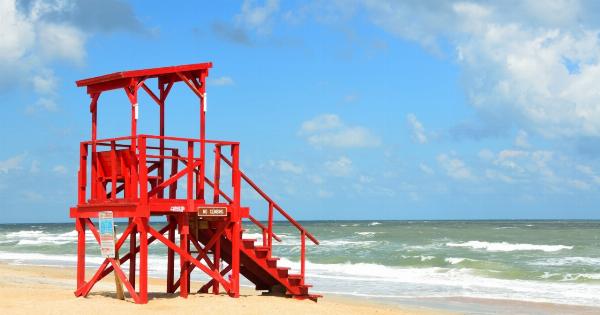The sun, the sand, and the gentle crashing of waves against the shore. There’s nothing quite like a day at the beach. It’s a place where people go to relax, unwind, and escape from the stress of everyday life.
But beneath the surface of this idyllic setting, lies a hidden world that many beachgoers are unaware of – a world teeming with germs and bacteria. In this article, we will explore the surprising truth about beach germs and how to protect yourself from potential health risks.
The Most Common Beach Germs
Before delving into the specifics, it’s important to understand that the beach is a natural environment where germs thrive.
While exposure to some germs is unavoidable and even beneficial for our immune systems, there are certain types of germs commonly found at beaches that can cause illnesses and infections.
1. E. coli
One of the most notorious beach germs is Escherichia coli, or E. coli for short. E. coli is a type of bacteria that resides in the intestines of humans and animals. While most strains of E. coli are harmless, some can cause severe gastrointestinal issues.
Contaminated water, fecal matter, or improperly cooked food are common sources of E. coli at the beach.
2. Staphylococcus aureus
Staphylococcus aureus, commonly known as staph, is another common beach germ. This bacterium can cause skin infections and, in some cases, more serious conditions such as pneumonia and bloodstream infections.
Staph can easily be transmitted through direct contact with contaminated surfaces or through open cuts and wounds.
3. Norovirus
Norovirus, often referred to as the “stomach flu,” is highly contagious and can spread rapidly in crowded beach areas. This virus causes gastroenteritis, leading to symptoms like vomiting, diarrhea, and stomach cramps.
Poor hygiene practices and contaminated food or water are the primary sources of norovirus at the beach.
4. Fungi
Fungal infections are also common at the beach, particularly in warm and humid climates. One well-known example of a beach fungus is Athlete’s foot, which thrives in damp environments like public showers and sandy areas.
Fungi can also cause nail infections and other skin irritations.
5. Pseudomonas aeruginosa
Pseudomonas aeruginosa is a bacteria often found in beach water and moist areas. While it rarely causes illness in healthy individuals, it can lead to infections in wounds or compromised immune systems.
Pseudomonas infections can result in skin rashes, ear infections, or urinary tract infections.
Ways to Protect Yourself from Beach Germs
Although beach germs may sound alarming, there’s no need to panic. With proper precautionary measures, you can still enjoy your time by the seaside while minimizing the risk of infections.
Here are a few essential tips to protect yourself from beach germs:.
1. Choose a Clean Beach
Research beach cleanliness ratings online before your visit. Look for beaches with excellent water quality and sanitation practices.
Well-maintained beaches often have regular inspections and follow strict protocols to minimize the presence of harmful bacteria.
2. Avoid Untreated Water
Swimming or engaging in water activities at untreated beaches, lakes, or ponds can increase your exposure to harmful germs.
Stick to designated swimming areas or opt for beaches with good water treatment systems to reduce the risk of waterborne infections.
3. Practice Good Hygiene
Wash your hands thoroughly with soap and water before and after visiting the beach. This simple act can significantly reduce the transfer of germs.
Additionally, avoid touching your face, especially your eyes, nose, and mouth with unwashed hands to prevent germ transmission.
4. Bring Your Own Beach Gear
Sharing beach equipment such as towels, toys, or beach chairs can facilitate the spread of germs. Bring your own gear whenever possible to minimize direct contact with contaminated surfaces and reduce the risk of infections.
5. Stay Away from Wildlife
While interacting with wildlife at the beach can be an exciting experience, it’s important to maintain a safe distance.
Avoid feeding birds or other animals, as their droppings can contain harmful bacteria and attract pests that carry additional germs.
6. Protect Cuts and Wounds
Use waterproof bandages or dressings to cover any cuts, scrapes, or wounds while at the beach. This will create a barrier against potential germs present in sand or water, reducing the risk of infection.
7. Be Cautious with Food
Foodborne illnesses are common, especially when consuming food at the beach. Avoid leaving perishable foods unrefrigerated for prolonged periods and practice proper food safety measures, such as washing fruits and vegetables before consumption.
Additionally, ensure that the water used for cooking or washing dishes is clean and safe.
8. Rinse Off After Swimming
After taking a dip, make sure to rinse off with freshwater to remove any potential germs clinging to your skin. This simple step helps eliminate saltwater, bacteria, and other contaminants from the beach and reduces the likelihood of skin infections.
9. Shower Before Heading Home
Once you’re done enjoying the beach, take a thorough shower with soap to cleanse your body. This will help remove any residual germs, sand, or sea salt, ensuring you don’t bring beach contaminants into your home.
10. Boost Your Immune System
A strong immune system is essential in fighting off potential infections. Maintain a healthy lifestyle by consuming a balanced diet, staying hydrated, exercising regularly, and getting enough sleep.
Proper nutrition and self-care contribute to a more resilient immune system.
Conclusion
The beach is undoubtedly a wonderful place to relax and soak up the sun. However, it’s essential to be aware of the potential risks posed by beach germs.
By following good hygiene practices, being mindful of water quality, and taking precautions, you can enjoy the beach while minimizing the chances of falling ill. So, next time you pack your beach bag, remember to protect yourself from those unseen beach germs!.































